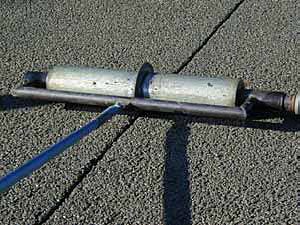Project Details
04/01/16
04/30/18
National Concrete Pavement Technology Center
Researchers
About the research
Automated plate load testing (APLT) was conducted on County Road V-18 in Poweshiek County, Iowa, to assess and compare performance of unbonded concrete overlay sections constructed in 2008–2009. The unbonded overlays on County Road V-18 were constructed in selected areas using an asphalt concrete (AC) interlayer or a non-woven geotextile fabric interlayer. Wiegand et al. (2010) documented the construction techniques and materials used to build the test sections (project TR-600). The results of the study documented here provide a new assessment of the in situ deformation and composite modulus of the test sections.
Test results showed that the core thicknesses varied between 8.8 and 10.2 in. in sections with the geotextile interlayer, and 7.3 and 7.6 in. in sections with the AC interlayer. The geotextile fabric was about 0.1 in. thick and the AC layer was about 0.5 in. thick. Cyclic APLT results indicated that, on average, the composite resilient modulus was 40 percent higher, permanent deformation was lower, and the exponent in the power model that defined number of cycles vs. permanent deformation was lower in the geotextile sections than in the AC layer sections. Because the data set obtained in this study did not include the mechanistic properties of the underlying layers, additional APLT testing is recommended. Future testing should also assess the in situ drainage difference between sections and the ride quality (e.g., international roughness index (IRI) and pavement condition index (PCI)) between different pavement interlayer types.
Project Details
2006-01
08/01/05
02/01/06
Iowa Concrete Paving Association
Iowa Department of Transportation
National Concrete Pavement Technology Center
Researchers
Vern Schaefer
David White
Muhannad Suleiman
John Kevern
About the research
Portland cement pervious concrete (PCPC) is being used more frequently due to its benefits in reducing the quantity of runoff water, improving water quality, enhancing pavement skid resistance during storm events by rapid drainage of water, and reducing pavement noise. In the United States, PCPC typically has high porosity and low strength, which has resulted in the limited use of pervious concrete, especially in hard wet freeze environments (e.g., the Midwestern and Northeastern United States and other parts of the world). Improving the strength and freeze-thaw durability of pervious concrete will allow an increase in its use in these regions.
The objective of this research is to develop a PCPC mix that not only has sufficient porosity for stormwater infiltration, but also desirable strength and freeze-thaw durability. In this research, concrete mixes were designed with various sizes and types of aggregates, binder contents, and admixture amounts. The engineering properties of the aggregates were evaluated. Additionally, the porosity, permeability, strength, and freeze-thaw durability of each of these mixes was measured.
Results indicate that PCPC made with single-sized aggregate has high permeability but not adequate strength. Adding a small percent of sand to the mix improves its strength and freeze-thaw resistance, but lowers its permeability. Although adding sand and latex improved the strength of the mix when compared with single-sized mixes, the strength of mixes where only sand was added were higher. The freeze-thaw resistance of PCPC mixes with a small percentage of sand also showed 2% mass loss after 300 cycles of freeze-thaw. The preliminary results of the effects of compaction energy on PCPC properties show that compaction energy significantly affects the freeze-thaw durability of PCPC and, to a lesser extent, reduces compressive strength and split strength and increases permeability.
